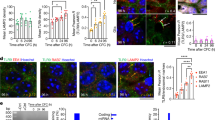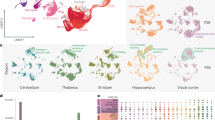Abstract
Neurogenesis normally only occurs in limited areas of the adult mammalian brain—the hippocampus1, olfactory bulb2,3,4 and epithelium5, and at low levels in some regions of macaque cortex6. Here we show that endogenous neural precursors can be induced in situ to differentiate into mature neurons, in regions of adult mammalian neocortex that do not normally undergo any neurogenesis. This differentiation occurs in a layer- and region-specific manner, and the neurons can re-form appropriate corticothalamic connections. We induced synchronous apoptotic degeneration7,8 of corticothalamic neurons in layer VI of anterior cortex of adult mice and examined the fates of dividing cells within cortex, using markers for DNA replication (5-bromodeoxyuridine; BrdU) and progressive neuronal differentiation. Newly made, BrdU-positive cells expressed NeuN, a mature neuronal marker, in regions of cortex undergoing targeted neuronal death and survived for at least 28 weeks. Subsets of BrdU+ precursors expressed Doublecortin, a protein found exclusively in migrating neurons9,10, and Hu, an early neuronal marker11,12. Retrograde labelling from thalamus demonstrated that BrdU+ neurons can form long-distance corticothalamic connections. Our results indicate that neuronal replacement therapies for neurodegenerative disease and CNS injury may be possible through manipulation of endogenous neural precursors in situ.
This is a preview of subscription content, access via your institution
Access options
Subscribe to this journal
Receive 51 print issues and online access
$199.00 per year
only $3.90 per issue
Buy this article
- Purchase on Springer Link
- Instant access to full article PDF
Prices may be subject to local taxes which are calculated during checkout




Similar content being viewed by others
References
Altman, J. & Das, G. D. Autoradiographic and histological evidence of postnatal hippocampal neurogenesis in rats. J. Comp. Neurol. 124, 319–335 ( 1965).
Altman, J. Autoradiographic and histological studies of postnatal neurogenesis. IV. Cell proliferation and migration in the anterior forebrain, with special reference to persisting neurogenesis in the olfactory bulb. J. Comp. Neurol. 137, 433–457 ( 1969).
Luskin, M. B. Restricted proliferation and migration of postnatally generated neurons derived from the forebrain subventricular zone. Neuron 11, 173–189 (1993).
Lois, C. & Alvarez-Buylla, A. Proliferating subventricular zone cells in the adult mammalian forebrain can differentiate into neurons and glia. Proc. Natl Acad. Sci. USA 90, 2074–2077 (1993).
Kaplan, M. S. & Hinds, J. W. Neurogenesis in the adult rat: electron microscopic analysis of light radioautographs. Science 197, 1092–1094 ( 1977).
Gould, E., Reeves, A. J., Graziano, M. S. A. & Gross, C. G. Neurogenesis in the neocortex of adult primates. Science 286, 548–552 (1999).
Macklis, J. D. Transplanted neocortical neurons migrate selectively into regions of neuronal degeneration produced by chromophore-targeted laser photolysis. J. Neurosci. 13, 3848–3863 (1993).
Sheen, V. L. & Macklis, J. D. Targeted neocortical cell death in adult mice guides migration and differentiation of transplanted embryonic neurons. J. Neurosci. 15, 8378– 8392 (1995).
Gleeson, J. G., Lin, P. T., Flanagan, L. A. & Walsh, C. A. Doublecortin is a microtubule-associated protein and is expressed widely by migrating neurons. Neuron 23, 257– 271 (1999).
Francis, F. et al. Doublecortin is a developmentally regulated, microtubule-associated protein expressed in migrating and differentiating neurons. Neuron 23, 247–256 ( 1999).
Marusich, M. F., Furneaux, H. M., Henion, P. D. & Weston, J. A. Hu neuronal proteins are expressed in proliferating neurogenic cells. J. Neurobiol 25, 143–155 (1994).
Barami, K., Iversen, K., Furneaux, H. & Goldman, S. A. Hu protein as an early marker of neuronal phenotypic differentiation by subependymal zone cells of the adult songbird forebrain. J. Neurobiol. 28, 82–101 (1995).
Reh, T. A. Cell-specific regulation of neuronal production in the larval frog retina. J. Neurosci. 7, 3317–3324 (1987).
Parent, J. M. et al. Dentate granule cell neurogenesis is increased by seizures and contributes to aberrant network reorganization in the adult rat hippocampus. J. Neurosci. 17, 3727– 3738 (1997).
Snyder, E. Y., Yoon, C., Flax, J. D. & Macklis, J. D. Multipotent neural precursors can differentiate toward replacement of neurons undergoing targeted apoptotic degeneration in adult mouse neocortex. Proc. Natl Acad. Sci. USA 94, 11663–11668 (1997).
Kirn, J. R. & Nottebohm, F. Direct evidence for loss and replacement of projection neurons in adult canary brain. J. Neurosci. 13, 1654–1663 (1993).
Gould, E. & Cameron, H. A. Regulation of neuronal birth, migration and death in the rat dentate gyrus. Dev. Neurosci. 18, 22–35 (1996).
Wang, Y., Sheen, V. L. & Macklis, J. D. Cortical interneurons upregulate neurotrophins in vivo in response to targeted apoptotic degeneration of neighboring pyramidal neurons. Exp. Neurol. 154, 389 –402 (1998).
Hernit-Grant, C. S. & Macklis, J. D. Embryonic neurons transplanted to regions of targeted photolytic cell death in adult mouse somatosensory cortex re-form specific callosal projections. Exp. Neurol. 139, 131–142 (1996).
Shin, J. S. Transplanted neuroblasts differentiate appropriately into projection neurons with the correct neurotransmitter and receptor phenotype in neocortex undergoing targeted projection neuron neurodegeneration. J. Neurosci. (in the press).
Scharff, C. et al. Targeted neuronal death affects neuronal replacement and vocal behavior in adult songbirds. Neuron 25, 481–492 (2000).
Palmer, T. D. et al. Fibroblast growth factor-2 activates a latent neurogenic program in neural stem cells from diverse regions of the adult CNS. J. Neurosci. 19, 8487–8497 (1999).
Reynolds, B. A. & Weiss, S. Generation of neurons and astrocytes from isolated cells of the adult mammalian central nervous system. Science 255, 1707– 1710 (1992).
Richards, L. J., Kilpatrick, T. J. & Bartlett, P. F. De novo generation of neuronal cells from the adult mouse brain. Proc. Natl Acad. Sci. USA 89 , 8591–8595 (1992).
Vescovi, A. L., Reynolds, B. A., Fraser, D. D. & Weiss, S. bFGF regulates the proliferative fate of unipotent (neuronal) and bipotent (neuronal/astroglial) EGF-generated CNS progenitor cells. Neuron 11, 951–966 ( 1993).
Morshead, C. M. et al. Neural stem cells in the adult mammalian forebrain: a relatively quiescent subpopulation of subependymal cells. Neuron 13, 1071–1082 (1994).
Craig, C. G. et al. In vivo growth factor expansion of endogenous subependymal neural precursor cell populations in the adult mouse brain. J. Neurosci. 16, 2649–2658 (1996).
Kuhn, H. G. et al. Epidermal growth factor and fibroblast growth factor-2 have different effects on neural progenitors in the adult rat brain. J. Neurosci. 17, 5820–5829 (1997).
Zigova, T., Pencea, V., Wiegand, S. J. & Luskin, M. B. Intraventricular administration of BDNF increases the number of newly generated neurons in the adult olfactory bulb. Mol. Cell. Neurosci. 11, 234–245 (1998).
Cameron, H. A., Hazel, T. G. & McKay, R. D. Regulation of neurogenesis by growth factors and neurotransmitters. J. Neurobiol. 36, 287 –306 (1998).
Guillery, R. W. & Herrup, K. Quantification without pontification: choosing a method for counting objects in sectioned tissues. J. Comp. Neurol. 386, 2– 7 (1997).
Acknowledgements
We thank J. Gleeson, S. Goldman, M. Marusich, C. Walsh, and P. Follett for reagents; M. Christian and C. Tai for technical assistance; L. Catapano, P. Follett, R. Fricker, M. Gates, and J. Gleeson for discussions; and L. Benowitz, M. Greenberg, L. Kunkel, and C. Walsh for critical reading. This work was supported by grants from the NIH (J.D.M.), Alzheimer's Association (J.D.M.), Human Frontiers Science Program (J.D.M.), an NIH predoctoral training grant (S.S.M.), and a postdoctoral fellowship from the Canadian MRC (B.R.L.).
Author information
Authors and Affiliations
Corresponding author
Rights and permissions
About this article
Cite this article
Magavi, S., Leavitt, B. & Macklis, J. Induction of neurogenesis in the neocortex of adult mice. Nature 405, 951–955 (2000). https://doi.org/10.1038/35016083
Received:
Accepted:
Issue Date:
DOI: https://doi.org/10.1038/35016083
This article is cited by
-
Stroke and Neurogenesis: Bridging Clinical Observations to New Mechanistic Insights from Animal Models
Translational Stroke Research (2024)
-
New balance capability index as a screening tool for mild cognitive impairment
BMC Geriatrics (2023)
-
Laminin-coated electronic scaffolds with vascular topography for tracking and promoting the migration of brain cells after injury
Nature Biomedical Engineering (2023)
-
IRES-mediated Wnt2 translation in apoptotic neurons triggers astrocyte dedifferentiation
npj Regenerative Medicine (2022)
-
Zeb2/Axin2-Enriched BMSC-Derived Exosomes Promote Post-Stroke Functional Recovery by Enhancing Neurogenesis and Neural Plasticity
Journal of Molecular Neuroscience (2022)
Comments
By submitting a comment you agree to abide by our Terms and Community Guidelines. If you find something abusive or that does not comply with our terms or guidelines please flag it as inappropriate.



